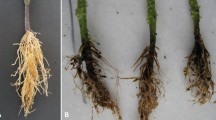Summary
Gene(s) conferring high soluble solids (SS) in tomato fruit had been backcrossed previously from a wild tomato species, Lycopersicon chmielewskii LA1028 (∼ 10% SS), into a L. esculentum cultivar, VF36 (∼ 5% SS), to derive a BC5S5 line, LA1563, similar to ‘VF 36’ but with 7–8% SS. DNAs from these lines and a tomato breeding line, H2038, were screened for restriction fragment length polymorphisms (RFLPs) using four restriction endonucleases and sixty clones chosen at random from a tomato cDNA library. Most of the cDNA clones (56) identified the same RFLP in ‘VF 36’ and LA1563 and a different RFLP in LA1028. However, two cDNA clones identified the same RFLP in LA1563 and LA1028 and a different RFLP in ‘VF36’. To determine whether RFLPs identified by these two cDNA clones were linked to SS genes, a H2038 x LA1563 F2 population was screened for segregation of the RFLPs and for SS content. The segregation ratios of these RFLPs were consistent with ratios expected for codominant alleles at unlinked loci. Analysis of variance of SS content for different RFLP genotypic classes indicated that RFLP alleles at one of the loci were linked to genes controlling SS content. The RFLP allele from the high SS tomato line, LA1563, was associated with significantly higher SS content and, therefore, could be useful in selecting for high SS gene(s) in a tomato breeding program.
Similar content being viewed by others
References
Alexander DC, McKnight TD, Williams BG (1984) A simplified and efficient vectorprimer cDNA cloning system. Gene 31:79–89
Beckmann JS, Soller M (1983) Restriction fragment length polymorphisms in genetic improvement: methodologies, mapping and costs. Theor Appl Genet 67:35–43
Birnboim HC, Doly J (1979) A rapid alkaline extraction procedure for screening recombinant plasmid DNA. Nucleic Acids Res 7:1513–1523
Burr B, Evola SV, Burr FA, Beckmann JS (1983) The application of restriction fragment length polymorphism to plant breeding. In: Setlow JK, Hollaender A (eds), Genetic engineering principles and methods, Vol 5. Plenum Press, New York, pp 45–59
Helentjaris T, King G, Slocum M, Siedenstrang C, Wegman S (1985) Restriction fragment polymorphisms as probes for plant diversity and their development as tools for applied plant breeding. Plant Mol Biol 5:109–118
Helentjaris T, Slocum M, Wright S, Schaefter A, Nienhuis J (1986) Construction of genetic linkage maps in maize and tomato using restriction fragment length polymorphisms. Theor Appl Genet 72:761–769
Ibarbia EA, Lambeth VN (1969) Inheritance of soluble solids in a large/small-fruited tomato cross. J Am Soc Hortic Sci 94:496–498
Kahn M, Kolter R, Thomas C, Figurski D, Myer R, Remaut E, Helinki D (1979) Plasmid cloning vehicles derived from plasmids ColE1, F, R6K and RK2. Methods Enzymol 68:268–280
Lower RL, Thompson AE (1967) Inheritance of acidity and solids content of small-fruited tomatoes. Proc Am Soc Hortic Sci 91:486–494
Mather K (1951) The measurement of linkage in heredity. Wiley and Sons, New York, pp 32–55
Rick CM (1974) High soluble-solids content in large-fruited tomato lines derived from a wild green-fruited species. Hilgardia 42:493–510
Rivin CJ, Zimmer EA, Cullis CA, Walbot V, Huynh T, Davis R (1983) Evaluation of genomic variability at the nucleic acid level. Plant Mol Biol Rep 1:9–16
Saghi-Maroot MA, Soliman KM, Jorgensen R, Allard RW (1984) Ribosomal DNA spacer length polymorphism in barley: Mendelian inheritance, chromosomal location, and population dynamics. Proc Natl Acad Sci USA 81:8014–8018
Soller M, Beckmann JS (1983) Genetic polymorphism in varietal identification and genetic improvement. Theor Appl Genet 67:25–33
Southern EM (1975) Detection of specific sequences among DNA fragments separated by gel electrophoresis. J Mol Biol 98:503–517
Stoner AK, Thompson AE (1966) A diallel analysis of solids in tomatoes. Euphytica 15:377–382
Taub F, Thompson EB (1982) An improved method for preparing large arrays of bacterial colonies containing plasmids for hybridization: In situ purification and stable binding of DNA on paper filters. Anal Biochem 126:222–230
Vallejos CE, Tanksley SD, Bernatzky R (1986) Localization in the tomato genome of DNA restriction fragments containing sequence homologous to the rRNA (45S), the major chlorophyll a/b binding polypeptide and the ribulose biphosphate carboxylase genes. Genetics 112:93–105
Author information
Authors and Affiliations
Additional information
Communicated by H.F.Linskens
Rights and permissions
About this article
Cite this article
Osborn, T.C., Alexander, D.C. & Fobes, J.F. Identification of restriction fragment length polymorphisms linked to genes controlling soluble solids content in tomato fruit. Theoret. Appl. Genetics 73, 350–356 (1987). https://doi.org/10.1007/BF00262500
Received:
Accepted:
Issue Date:
DOI: https://doi.org/10.1007/BF00262500




